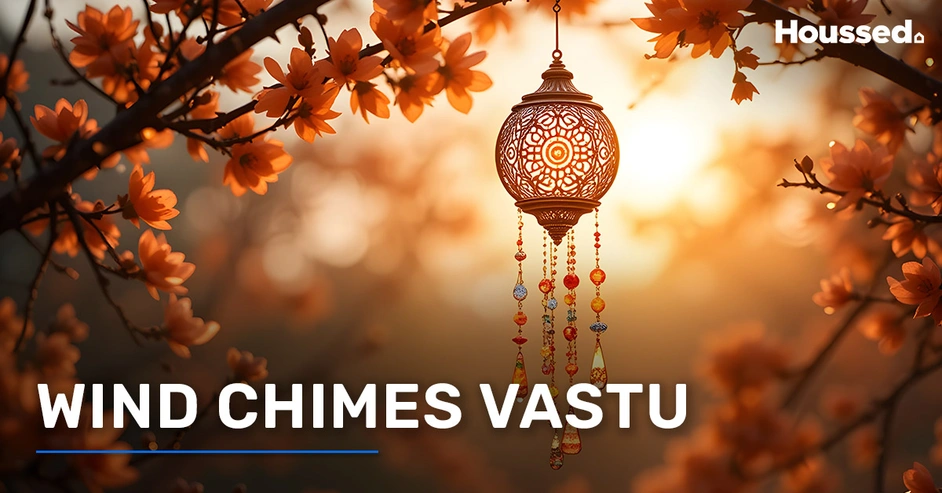Wind Chimes Vastu - Everything You Should Know (2025)

Among the various tools recommended by Vastu, wind chimes stand out for their ability to harmonise the five elements: Earth, Water, Fire, Air, and Space. When placed correctly, they can dispel negative energies and invite positivity, prosperity, and peace.
This comprehensive guide explores the significance of wind chimes Vastu, including optimal placements, suitable materials, ideal rod counts, and common mistakes to avoid, helping you harness their full potential for a harmonious living space.
Benefits of Wind Chimes as per Vastu
Wind chimes are more than decorative pieces; they are tools to harmonise energy in our homes. According to Vastu Shastra, the gentle sounds they produce can usher in positivity and dispel negativity.
Key Benefits:
- Positive Energy Flow: The melodious tones help in circulating positive energy throughout the space.
- Stress Reduction: Their soothing sounds can calm the mind, reducing anxiety and promoting relaxation.
- Wealth Attraction: Strategically placed wind chimes can attract prosperity and financial growth.
- Health Enhancement: They aid in balancing energies, which can lead to improved health and well-being.
- Enhanced Relationships: When placed in the Northwest direction, Wind chimes in Vastu can help foster harmonious connections and open doors to new opportunities.
Also Read - Feng Shui Coins
Types of Wind Chimes With the Right Direction as per Vastu
1: Metal Wind Chimes
Metal wind chimes, often crafted from aluminium, bronze, brass, or copper, are revered in Vastu for their ability to attract prosperity and ward off negative energies.
When placed in the North, they enhance career prospects and financial growth. Positioning them in the West or Northwest can stimulate creativity and bring joy to family life.
Their resonant tones are believed to cut through stagnant energies, promoting a vibrant and positive atmosphere.
2: Ceramic/Clay Wind Chimes
Ceramic or clay wind chimes embody the earth element, symbolising stability and a sense of grounding. Ideal placements include the Southwest, Northeast, and Centre of the home.
In the Southwest, they enhance love and relationships; in the Northeast, they foster knowledge and spiritual growth; and at the Centre, they promote overall well-being and harmony.
3: Wooden/Bamboo Chimes
Wooden or bamboo wind chimes resonate with the wood element, representing growth and vitality. Placing them in the East supports health and family harmony, while the Southeast placement attracts wealth and abundance.
Their gentle sounds are believed to help the environment, encouraging a nurturing and prosperous space.
4: Crystal Wind Chimes
Crystal wind chimes, with their sparkling appearance and clear tones, are associated with clarity and healing. Positioning them in the Southwest can amplify love energies and enhance relationships.
Their reflective surfaces are also believed to deflect negative energies, creating a peaceful ambience.
5: Seashell Wind Chimes
Seashell wind chimes in Vastu bring the calming essence of the ocean into the home. Best placed in the South or Southeast, they are believed to attract tranquillity and prosperity.
Their natural textures and soothing sounds create a serene environment, promoting relaxation and positive energy flow.
Also Read - Laughing Buddha for Home
Wind Chimes Direction for Home as per Vastu
According to Vastu, the following directions of the wind chimes must be preferred for better results:
1: Bedroom
In the bedroom, tranquillity and restfulness are paramount. Placing wind chimes at the entrance or window leading to the balcony allows the gentle breeze to create soothing sounds, promoting relaxation and better sleep.
Ceramic wind chimes in the West, Northwest, or Southwest directions are considered beneficial for fostering love and romance.
It's advisable to avoid hanging wind chimes directly above the bed or seating areas, as this can disrupt the peaceful energy flow.
2: Pooja Room
Incorporating bells or wind chimes in the pooja room can enhance the spiritual ambience. Traditionally, a brass bell is placed on the left side of the temple area.
According to Vastu Shastra, wind chimes adorned with symbols such as Ganesha, elephants, or peacocks can further amplify positive energies.
Placing wind chimes in the East or Southeast direction brings good health and enhances the positive energy of the space.
The resonating sound of these chimes is believed to purify the space, removing negative energies and inviting positivity.
3: Living Room
The living room serves as a central gathering space, and its energy should be vibrant yet harmonious. Metal wind chimes, such as those made from aluminium or brass, are ideal for this area.
Placing them in the West direction can attract creativity and well-being for the family. The clear, resonant tones of metal chimes help dispel negative energies, enhancing communication and clarity within the home.
4: Entrance
Entrances are crucial in Vastu, as they serve as the primary channels for energy flow. Hanging wind chimes near the main door can help circulate positive energy throughout the living space.
However, it's essential not to place them directly above or on the front door. Instead, position them on either side of the door to avoid obstructing the flow of energy. This placement ensures that the pleasant sounds of the chimes welcome guests and positive energies alike.
According to Vastu Shastra, wind chimes placed at the entrance, ideally facing the North, West, or Northwest, can bring good luck and honour.
5: Centre of the House
The centre of the house, known as the Brahmasthan, is considered the heart of the home in Vastu Shastra. Placing wind chimes here can help neutralise any negative energy and enhance the overall energy flow.
It's advisable to use ceramic or clay wind chimes in this area, as they represent the earth element, promoting stability and grounding. Ensure that the chimes are placed in a location where their sound can be heard from all directions, facilitating a harmonious environment.
Also Read - Water Fountain for Home Vastu
Ideal Outdoor Wind Chimes Vastu Direction
- Garden: Use bamboo chimes in the East to promote growth.
- Balcony: Metal chimes in the north to attract career opportunities.
- Avoid hanging metal chimes on trees to prevent elemental clashes.
Shapes of Wind Chimes as per Vastu
In Vastu Shastra, the shape of a wind chime significantly influences the type of energy it attracts and disperses within a space. Each form resonates with specific elements and purposes, making it essential to choose a shape that aligns with your intentions.
1: Cylindrical or Tubular Wind Chimes
Cylindrical and tubular wind chimes are the most common and are often made of metal or bamboo. Its elongated shape allows for a range of tones, promoting a calming atmosphere.
When placed in the Southwest direction, they are believed to enhance relationships and bring stability to the household.
2: Bell-Shaped Wind Chimes
Resembling traditional bells, these chimes produce a clear, resonant sound that is thought to ward off negative energies. They are particularly effective when hung near entrances, inviting positivity and protecting the home from external negativity.
3: Geometric Shapes
Wind chimes featuring geometric designs such as stars or circles are not only aesthetically pleasing but also symbolise completeness and harmony. These shapes can be placed in the East or Southeast directions to promote growth and prosperity.
4: Spiral or Helix Wind Chimes
The spiral design represents evolution and growth. These chimes are believed to stimulate creativity and can be beneficial in study rooms or offices, especially when placed in the Northwest direction.
5: Glass With Seashell Wind Chimes
Combining the reflective quality of glass with the natural elements of seashells, these chimes are ideal for attracting positive energy and tranquillity. They are best suited for the South or southeast directions, enhancing wealth and relaxation.
Also Read - Elephant Statue at Home as per Vast
Number of Rods in Wind Chimes as per Vastu
1: Four-Rod Wind Chimes
When it comes to wind chimes Vastu, four-rod wind chimes are associated with stability and grounding. When placed near entrances, they are said to attract positive energy and good fortune into the home. It also offers a welcoming atmosphere for both residents and guests.
2: Five-Rod Wind Chime
Representing the five elements, earth, water, fire, air, and space, five-rod wind chimes aim to harmonise the natural energies within a space.
They are often recommended for living rooms, especially in the southeast direction, to promote balance and well-being.
These chimes help in synchronising individuals with the natural elements, preventing negative energy and ill luck.
3: Six-Rod Metal Wind Chimes
Six-rod wind chimes are commonly used to ward off negative energies and attract prosperity. They are considered beneficial for career growth and are often placed in the north or northwest areas of a home or office.
These chimes are known to attract positive energy, filling spaces with positive vibes and bringing good luck and success.
4: Seven-Rod Wind Chime
Seven-rod metal wind chimes, often used on special occasions, help establish harmony in a house by generating melodic sounds from pleasant breezes, typically placed near a door or window.
When hung on the western side, they boost the creativity of family members and are typically used to bring good fortune to youngsters.
Also Read - 7 Horses Painting Vastu
Colours & Placement of Wind Chimes Vastu
Red
Red symbolises passion, energy, and vitality. Incorporating red wind chimes can invigorate the environment, fostering enthusiasm and motivation.
Ideal Direction for Red Wind Chimes: Placing them in the South direction is believed to enhance fame and recognition, while positioning them in the Southwest can strengthen relationships and love bonds.
However, due to its intense energy, it's advisable to avoid red wind chimes in bedrooms or meditation spaces to maintain tranquillity.
2: Blue
Blue embodies calmness, wisdom, and depth. Blue wind chimes can introduce a serene ambience, promoting clarity and peace.
Direction for Blue Wind Chimes: When hung in the North direction, they are believed to bolster career prospects and financial stability. Their soothing tones can also help reduce stress, making them suitable for study rooms or offices.
3: White
White wind chimes can purify the environment, dispelling negativity and fostering a sense of openness.
According to Vastu, positioning them in the West direction is believed to enhance creativity and support the well-being of children. Their gentle sounds can also aid in meditation and introspection.
4: Green
Green wind chimes can rejuvenate spaces, promoting healing and balance. Their presence can be especially beneficial in areas where rejuvenation and vitality are desired.
Ideal Direction for Green Wind Chimes: Placing them in the East direction is believed to improve health and family harmony, while positioning them in the Southwest can attract prosperity and new opportunities.
5: Black
Black embodies depth, mystery, and introspection. To ensure success, it is recommended to place a black wind chime near your office door. Black wind chimes can absorb negative energies, offering protection and grounding.
Ideal Direction for Black Wind Chimes: When placed near the North or Northwest entrances, they are believed to enhance career opportunities and provide a shield against external negativity.
6: Yellow and Brown
Yellow symbolises joy, intellect, and energy, while brown represents stability and a sense of grounding. Yellow wind chimes can uplift moods and stimulate mental clarity, making them suitable for study areas or kitchens.
On the other hand, Brown wind chimes can instil a sense of security and balance, ideal for living rooms or spaces where stability is sought.
Ideal Direction for Yellow and Brown Wind Chimes: Positioning these chimes in the northwest direction is believed to enhance relationships and family bonds.
Also Read - Good Luck Paintings as per Vastu
Mistakes To Avoid in Wind Chimes Vastu Placement
Apart from decorating your house with an elegant wind chime, you must also avoid these mistakes as mentioned below:
- Hanging Wind Chimes Above Beds or Seating Areas: Placing wind chimes directly above beds or seating areas can lead to restlessness and disturbed sleep.
- Installing Wind Chimes on Doors or Door Frames: Mounting wind chimes on doors or their frames can obstruct the natural flow of energy.
- Placing Wind Chimes Too Close to Walls or Obstacles: Positioning wind chimes near walls, furniture, or plants can hinder their movement and sound production.
- Using Inappropriate Materials in Specific Directions: Each material resonates with different energies. For instance, metal wind chimes are best suited for the West or Northwest, while wooden ones are ideal for the East or Southeast.
- Hanging Wind Chimes in Inappropriate Areas: Avoid placing wind chimes in kitchens, bathrooms, or directly under staircases, as these locations can lead to energy imbalances and negate the positive effects of the chimes.
Summary
Benefits of Wind Chimes as per Vastu
- Positive Energy Flow
- Stress Reduction
- Wealth Attraction
- Health Enhancement
- Vastu Dosha Correction
Types of Wind Chimes With the Right Direction as per Vastu
- Metal Wind Chimes - North
- Ceramic/Clay Wind Chimes - Southwest, Northeast, and Centre of the home
- Wooden/Bamboo Chimes - East
- Crystal Wind Chimes - Southwest
- Seashell Wind Chimes - South or Southeast
Wind Chimes Direction for Home as per Vastu
- Bedroom - West, Northwest, or Southwest
- Pooja Room - East or Southeast
- Living Room - West
- Entrance - North, West, or Northwest
- Centre of the House
Right Wind Chimes Shapes as per Vastu
- Cylindrical or Tubular Wind Chimes
- Bell-Shaped Wind Chimes
- Geometric Shapes
- Spiral or Helix Wind Chimes
- Glass with Seashell Wind Chimes
Number of Rods in Wind Chimes as per Vastu
- Four-Rod Wind Chimes
- Five-Rod Wind Chime
- Six-Rod Metal Wind Chimes
- Seven-Rod Wind Chime
Colours & Placement of Wind Chimes in Vastu
- Red
- Blue
- White
- Green
- Black
- Yellow & Brown
Mistakes to Avoid in Wind Chimes Vastu Placement
- Hanging Wind Chimes Above Beds or Seating Areas
- Installing Wind Chimes on Doors or Door Frames
- Placing Wind Chimes Too Close to Walls or Obstacles
- Using Inappropriate Materials in Specific Directions
- Hanging Wind Chimes in Inappropriate Areas
FAQ's
Wind chimes are believed to harmonise the five elements, Earth, Water, Fire, Air, and Space, by producing soothing sounds that dispel negative energies and attract positivity.
Placement depends on the type of material, which includes:
- Metal chimes are ideal in the North, West, or Northwest
- Wooden chimes suit the East or Southeast
- Ceramic chimes are best in the Southwest, Northeast, or West.
Yes, when placed correctly, wind chimes can attract good luck, prosperity, and positive energy.
Some of the suitable materials for wind chimes include:
- Metals include brass, aluminium, and bronze
- Ceramic and Clay
- Wooden and Bamboo
- Crystal
- Seashell
Wind chimes with four, five, or six rods are considered auspicious. However, the number of rods used differs based on the Vastu application.
Yes, wind chimes can mitigate Vastu defects by balancing energies, especially when placed between opposing doors or in areas with energy imbalances.
Vastu Shastra does not specify a particular shape for a wind chime but emphasises the significance of the material and the number of rods.
The gentle, melodious sound of wind chimes is believed to enhance the flow of positive energy, while harsh or unpleasant tones may disrupt harmony.
Yes, wind chimes can be used in a bedroom, but their placement and sound should be carefully considered, as some may find them calming, while others may find them disruptive.
Yes, damaged or broken wind chimes can attract negative energy. It's essential to repair or replace them promptly to maintain a positive vibration.









